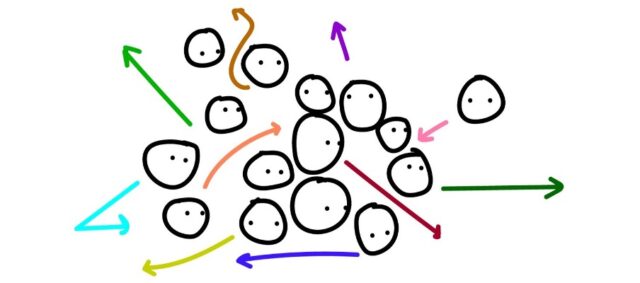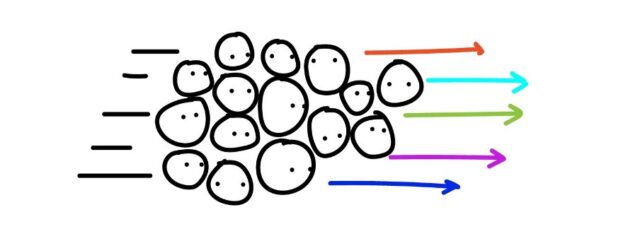It’s not every day you meet a team who can look at the minutia and still drive blue sky thinking, let alone tie those concepts together into a whole framework. But the innovators at mindful MATERIALS are doing just that, and Work in Mind got to sit down and chat with two of its key players, Alex Muller and Laurel Christensen.
Built of a diverse team of architects, designers, sustainability specialists, and industry thought leaders, mindful MATERIALS (mM) is a non-profit organisation aiming to move buildings material sustainability further, faster, together by working to solve common challenges. Their Common Materials Framework is a gamechanger, creating universal alignment around key standards and certifications in the materials and design world.
What we build is designed to help built environment professionals stop redoing work, and start taking more mindful action to manufacture and select materials.
What are both of your backgrounds and how to those play into your roles at mindfulMATERIALS?
Laurel: My background is in architecture, but interestingly enough, when I graduated with my Master’s in architecture, I actually went to the manufacturing side, and I worked as a rep for a Kentucky based manufacturer. I would call on architecture and engineering firms, providing lunch and learn presentations and talking about more efficient ways to design mechanical systems for occupant comfort. It was a really eye-opening experience for me because I would try and get people to think differently about how we design – to do so more sustainably, but there was always pushback.
Years later when I transitioned back to the design side of the industry and started learning about the wide-ranging impacts of the materials we specify, I was introduced to mindful MATERIALS through a roadshow event that Annie Bevan, now the CEO of mM, and several other manufacturers had put together. Annie shared a similar experience that really resonated with me, and I reached out afterwards to say ‘how can I get involved?!’. I spent a few years leading our A&D Engagement Group before officially becoming a part of the team as the Director of Outreach and Engagement.
Alex: I actually started off on the other side of things, doing a Masters in sustainability – my thesis was on transparency in building products. 8 years on I admit I’m curious about what I wrote, but writing a thesis was awful so I hope to never revisit it again. From there, I started in program development at the International Living Future Institute. I became really familiar with the philosophy of holistic sustainability and thinking about how a team comes together at the beginning of a project to make sure that sustainability is addressed at the onset, rather than as an afterthought later on.
Now as VP of Strategy and Communications at mindful MATERIALS, I love big-picture thinking. I love talking with a ton of people and getting their perspectives. And then I also get to translate the nerdier, more technical information about product data and sustainability into visuals and language that people can connect with so they can really feel the impact of materials and engage with the possibilities of shifting their decisions.

Tell us a bit more about the background of mM
Alex: At its core, mindful MATERIALS is a community, a hub where people can come together and connect ideas and learn from each other in this massive space of information on materials. And I think what we really provide to the industry is focus and unification so that everyone’s work can scale. mM is this neutral space in a sea of certifications and sustainability data and databases. What we want is to be the convener of information and the mechanism for alignment. And so by being this neutral convener, we give everybody this space to talk about shared challenges and work together to figure things out for broad benefit.
One of our biggest opportunities as designers and architects is to think about the materials that we use. So we’re ultimately planting those seeds and then helping others connect their values to their actions in designing with materials.
We also know that everything doesn’t have to be through us. If we can connect others to an organisation that has information that is useful to them, then that’s a huge part of our goal, too. Ultimately, we’re looking at the bigger picture of how to approach materials and creating a network behind that.
One of mindful MATERIALS’ core focuses is the Common Materials Framework (mM CMF). Tell us more about that.
Alex: The two really go hand in hand. If mindful MATERIALS is the community, then the Common Materials Framework is a foundational resource within that community. It provides a massive opportunity to align the foundations of the industry, to make data connect, to make ideas connect, to help inform and align material strategies and align the entire value team.
If you really boil it down, the Common Materials Framework is this external reference point that maps key points and creates a structure for sustainability data around different materials. It’s broken down into these five ‘buckets’ of sustainability and each ‘bucket’ has sub-buckets that point to programs that focus on this area. For example, if you want to look at Climate Health, a sub-bucket is company carbon. Then, the framework points you to programs and standards that are related, like SBTis or CDP.
With the CMF, firms, building owners and architects have an external framework to align around and figure out where the common ground is. And I think that’s so important. I’ve always felt it was important to have more alignment, but the CMF made me realise that perhaps people always wanted to align their standards, actions and demand — but they never had a framework to rally around. The CMF is a mechanism for this greater picture of ‘how do we start moving our momentum together in the same direction.’


At Work in Mind, a lot of our readers are architects, building managers, landlords, HR teams. How would you say these groups can start to integrate the framework? And what would you say is kind of the best way to start utilising it?
Laurel: I’ll be honest, It initially took me a week or two to remember those 5 buckets off the top of my head. One of the things that helped our team at Dyer Brown – the architecture firm where I work – keep these all top of mind, was tohire a local muralist to come in and paint on the wall in our materials library. It’s just nicely lettered and says, ‘we consider our impact on… climate health, human health, ecosystem health, social health & equity, and circularity
It will take a little time to get all the product sustainability data out there fully mapped and connected to the CMF, but in the meantime, these groups can incorporate and integrate the CMF into their decision-making processes in a bit more “analogue” way, if you will. We have a lot of resources on the mindful MATERIALS website, providing more details on our new Portal as well as an overview of the CMF which has a handy chart that breaks down at a high level which certifications relate to which buckets. Based on your project’s requirements, you can look at each bucket and see which certification or standard covers the most areas for you.

Will mindfulMATERIALS and the CMF be expanding beyond the US in the future?
Laurel: Yes absolutely, in the future we’re hoping to extend outwards from the US. Right now, we have a little over 150 certifications that are referenced in the common materials framework and they’re mostly North American based. We also have a number of international hubs – Latin America, India, and a few other in the works. Those are two of the most active that are really chomping at the bit to start adapting and expanding the CMF to their regions.
Alex: And the awesome thing is that because the CMF maps the sustainability data points that are out there, it is infinitely updatable and modular without changing the overall structure, right? So then we can ask: How does this data point fit in? How does this new standard apply? And that could be something that we work with those different hubs to identify.
How can readers follow along and connect with mM in the future?
Laurel: In the upcoming months, mindful MATERIALS will be busy networking, speaking, and showing up to various events. You can find us at the AIA Conference in San Francisco, and NeoCon in Chicago this June. We have a series of regional pop-up events coming in LA, Portland, and NYC, and we’ll have a strong presence, as usual, at the Greenbuild International Conference this year.
If you’re looking to get involved, we always welcome volunteers. That’s where a lot of our efforts and help come from! We have a few different ways to get involved, like volunteering in working and engagement groups, or even becoming a sponsor. And, of course, we always welcome new connections on LinkedIn.
Any final thoughts to leave our readers with?
Alex: If we take it back to the basics of designing, the embodied impact of the materials that you are using are multifaceted. They are interconnected and they are both local and global in nature. And so we cannot be thinking about material sustainability only as a point in a certification for a particular special project that you’re doing. We need to get to the point where, once again, it is the rule, not the exception, that you are addressing sustainability for materials from the start of a project.
And so I think if that is a statement that resonates with your readers, then we would invite them to visit our website, learn more about the common materials framework and understand its potential to make it easier for everybody to start taking on material sustainability. That’s our whole goal.
Sophie Crossley
Sophie Crossley is our Content Editor. She has 5+ years of experience in comms with a focus on wellbeing, the built environment, and lifestyle.




